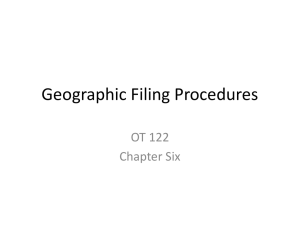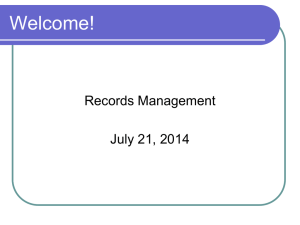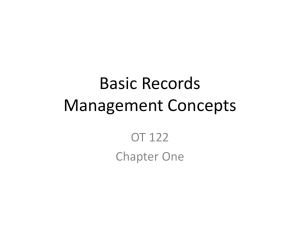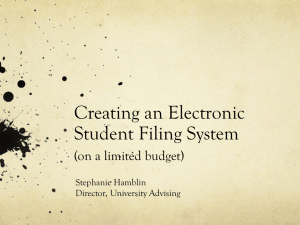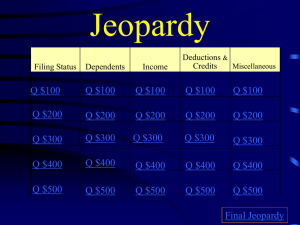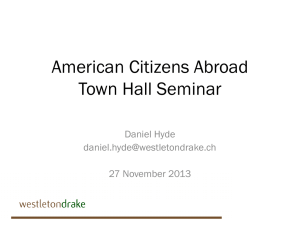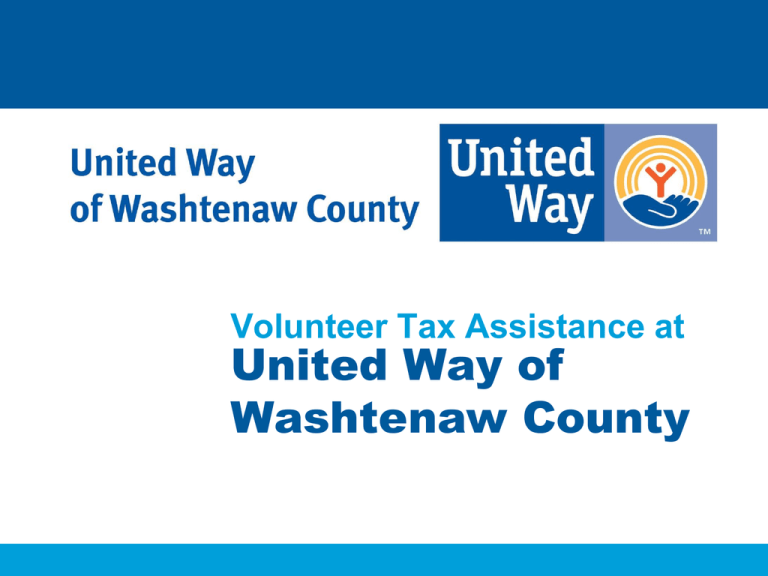
Volunteer Tax Assistance at
United Way of
Washtenaw County
Welcome to VITA!
And thank you for
volunteering for this
important service.
This is our 5th year serving Washtenaw County
Last year:
We prepared or assisted almost
a two hundred taxpayers
Most received refunds averaging
more than $1000! That’s more money
coming into Washtenaw County
There was more demand for assistance
than we could cover.
We are a “fusion” site
Running 2 programs at the same time:
1. Traditional VITA
We prepare the return for the taxpayer using
software you will be trained on.
2. Facilitated Self Assistance (FSA)
Also known as “MyFreeTaxes.com”
We coach the taxpayer in preparing their
own return using software.
What is VITA?
The VITA Program offers free tax help to people
who make $53,000 or less & need assistance
in preparing their own tax returns. IRScertified volunteers provide free basic income
tax return preparation with electronic filing to
qualified individuals in local communities.
This is our 5th year of offering VITA services in
Washtenaw County.
Traditional VITA – First Line of Service
Advantages:
• TP needs no expertise in computers, reading, English
or tax
• “Full service”, like going to a paid preparer
• Return quality-reviewed by 2nd volunteer
Disadvantages:
• Service limited to returns within scope of training
• Can’t prepare returns with missing documentation,
estimates, or where TP disagrees with preparer.
• By appointment only – Can only schedule if we know
we have volunteers.
Lesson 3 – Filing Basics
How VITA works
1. Client makes appointment through United Way & is mailed an intake
form to complete & a list of documents to bring. They are pre-screened
to determine if their return can be prepared under VITA program. If not,
they are offered the FSA program.
2. Client brings their records, ID & intake form to tax preparation site.
3. Greeter ensures client has proper documents & completed intake form,
then matches client to appropriately trained volunteer.
4. Volunteer interviews client, reviews documents & prepares return.
5. All returns are reviewed by a second volunteer with same or higher
level of certification. Most returns are e-filed the same day.
6. Client goes to exit table where copy of return is printed out, any paperfiled returns are printed out & signed & mailing instructions provided.
Client fills out exit survey.
VITA Variation – Scan & Go
Advantages:
• Same as traditional VITA
• Helps serve more taxpayers and better utilize
available volunteers
Disadvantages:
• Same as traditional VITA.
• Interviews and reviews more likely to be done by
phone
• Takes 1-2 weeks to get return back to taxpayer
Lesson 3 – Filing Basics
What is Facilitated Self-Assistance (FSA)?
Taxpayers prepare their own return using online
interview-based [H&R Block] software, while
IRS-certified volunteers stand ready to assist
with tax questions and/or computer issues.
FSA:
Increases taxpayer access to free services
• Empowers taxpayers to file independently
• Increases efficiencies to enhance return totals
FSA Software Model
MyFreeTaxes.com
• Free federal returns; free state returns in
all 50 states
• Income limit is $60,000 (individual or
family income)
FSA – Available as Alternative
Advantages:
• Walk-ins welcome on space-available basis.
• Can prepare returns with missing document, TP
estimates or where TP disagrees with preparer.
• Can decrease waiting time for volunteer help
Disadvantages:
• TP must be proficient in English & some computer
familiarity
• TP alone is responsible for return
• TP must prepare their own return, with coaching only
MyFreeTaxes User Support
MyFree Taxes Helpline : 1-866-My-Tx-Help
• All clients using MyFreeTaxes.com will be supported by
the MyFreeTaxes Helpline
• Hours of Operation: 10am – 8pm EST
• Helpline is staffed by select 2-1-1 centers & VITA
certified volunteers
• Email support is available 24/7 with a 24 hour response
time
• Chat support is available during hours of operation
• Support provided for system navigation, tax preparation
& if necessary other wrap around services
Info for all volunteers
How to make appointments
Schedule
Requirements for volunteers
Roles
Create your VITA Central Account
Standards of Conduct
Volunteer Protection Act
VSC Exam
Intake Presentation
How to Make Appointments
Know someone who needs VITA’s help?
Have them call (734) 667-7235 (United
Way) after January 15th for an
appointment.
Lesson 3 – Filing Basics
Current Schedule
Volunteer Shifts
Wednesdays 5-8:30pm
Saturdays 9am-5pm
Starting February 4th &
continuing until April 15
Lesson 3 – Filing Basics
Requirements for VITA volunteers
1. You do not need to have prior tax preparation
experience to volunteer.
• Only site coordinators need prior experience.
2. You do not have to be an attorney or an accountant.
• 10th grade education is required.
3. You will receive training on the tax preparation software
4. All tax returns we prepare will be reviewed by another
preparer
Roles for VITA volunteers
There are 4 roles for VITA volunteers:
1. Greeters must also review a greeter checklist before their
1st shift.
2. Tax Return Preparers must be certified at least to the basic
level, & preferably to the advanced level using IRS’s Link &
Learn Certification program, & also complete a State tax
certification.
3. Tax Return Reviewers must be certified at least to the
advanced level using IRS’s Link & Learn Certification
program & complete the State tax certification.
4. Site Coordinators need additional training & have VITA
experience.
Requirements for VITA volunteers
All VITA volunteers must adhere to IRS volunteer
standards of conduct, which requires them to view a
presentation & take a 10 question certification test.
All VITA volunteers must also review a Powerpoint
presentation regarding the intake form we use to
help clients with their taxes.
Return preparers/reviewers/site coordinators must
obtain additional training.
Once you are certified:
• Bring a photo ID & printed Volunteer Standards of
Conduct (VSC) Agreement (which will show your test
scores) for signature to United Way.
• Sign up for at least 3 shifts ASAP with Amanda Reel.
• We need 2 greeters, 2 reviewers & 8 preparers per shift.
• We are taking appointments for clients starting in
January, so signing up early helps us match clients to
volunteers meeting their language or certification needs.
Lesson 3 – Filing Basics
What do I do next?
Go to www.uwgive.org/vitavolunteers
to access training for either
“Greeters” or “Return Preparers”.
Pathways
Walk you through the steps
needed to be ready to volunteer.
Go to www.uwgive.org/vitavolunteers
to access training for either
“Greeters” or “Return Preparers”.
Step 1 is done. Now, step 2
Info for all volunteers
How to make appointments
Schedule
Requirements for volunteers
Roles
Create your VITA Central Account
Standards of Conduct
Volunteer Protection Act
VSC Exam
Intake Form Presentation – Watch on own and
bring signed certificate. (Yellow form available)
Info for Greeters
Greeter Job Description – Read through before
first shift
Sign up for shifts with Amanda
Come 15-30 minutes for your shift.
You will receive additional training then and
during your first shift (Scan & Go)
YOU ARE DONE FOR TRAINING!
VITA Tax Preparer Certification
Basic (required for
return preparers)
Lesson 2 – Screening &
Interviewing
Lesson 3 – Filing Basics
Intake & Interview Process
Form 13614-C is mandatory for all VITA/TCE sites
• See the Form 13614-C Job Aid
Remember:
• Screen for eligibility
• Check identity
• Check completed intake sheet for errors
• Review supporting documents
• Use probing questions
• “Unsure” responses must be changed to “Yes” or “No”
• Confirm the return is within program scope & your training
• Conduct a quality review after return is prepared
Lesson 2 – Screening & Interviewing
Lesson 3 – Filing Basics
26
Interview Techniques
How do you… ?
• Build rapport
• Ask effective questions
• Use active listening skills
• Overcome communication barriers
Important questions:
• Who lives in your house/apartment?
• Months/years in each home?
• Dependent relationship(s)?
• Marital status as of December 31?
Lesson 2 – Screening & Interviewing
Lesson 3 – Filing Basics
27
Resources & Reminder
Necessary tools for Screening & Interviewing (on TWEN & will
be on your computer on site):
• Form 13614-C, Intake/Interview & Quality Review Sheet
• Publication 4012, Volunteer Resource Guide
• Publication 17, Your Federal income Tax for Individuals
Safeguard all TP information – it is private & confidential
Lesson 2 – Screening & Interviewing
Lesson 3 – Filing Basics
28
New Topic - Who Must File a Tax Return
• What helps determine if an individual must file?
• Form 13614-C very important in this stage of the process
• Refer to Pub 4012, Charts A, B, & C, on pp A-1 to A-3, tab A
Lesson 3 – Filing Basics
29
Who Should File
• In what situations would an individual want to file if they are not
required to?
• Find examples in Pub 4012, Tab A, Chart D
• FAFSA!
• Out of scope:
• Health coverage tax credit
• Refundable credits for prior year minimum tax
• Adoption credit
Lesson 3 – Filing Basics
30
Verifying TP Identity
• What are acceptable identity documents to verify identity?
• See the Tip in Pub 4491
• What are acceptable TINs?
• Enter names & identification numbers accurately
• Mistakes in data entry can result in processing delays
• See Pub 4012 (Tab 1), Main Information Screen, for ID entries
• Verify TP information to protect against identity theft
• Remind TPs correct information is necessary to receive age-related tax
benefits
• Out of scope: TPs who cannot substantiate their identity – send them
to FSA side.
Lesson 3 – Filing Basics
31
Choosing the Right Return
• Volunteers should always use Form 1040
• Appropriate for all TPs
• Default TaxWise form
• TaxWise will select the simplest form after data entry
Lesson 3 – Filing Basics
32
Administrative Questions?
• FAQ answers:
• Pub 4012 (Tab P), Frequent TP Inquiries
• Pub 17 Index
• Internet: Filing Requirements
Lesson 3 – Filing Basics
33
Who’s your “family”/in your “household”?
This issue touches many areas of the tax return, but the 3
big ones are:
1. Filing Status (qualifying for more advantageous “head
of household”)
2. Dependency Exemptions (can someone claim a
person as a dependent on their tax return)
3. EITC (tax credit for working poor is larger if you have
qualifying children) & Child Tax Credits
Definitions are different for each, & some are not
intuitive (for example, in some cases your brother is
your “child”). Use the resources & never guess.
Lesson 3 – Filing Basics
34
Lesson 4 – Filing Status
Lesson 3 – Filing Basics
35
The Five Filing Statuses
• Find relevant TP information on Form 13614-C, Section A,
Part II: Marital Status & Household Information
• Filing status impacts:
• Calculation of income tax
• Amount of the standard deduction
• Allowance or limitation of certain credits &
deductions
• Use “HELP ME” function on Taxwise
• Pub 4012 (Tab B), Determination of Filing Status Decision
Tree, pp B-1 through B-3
• Pub 17, Chapter 2, Filing Status provides details
Lesson 43 – Filing Status
Basics
36
Single
• On the last day of 2014 TP was:
• Not married
• Legally separated or divorced, or
• Widowed before first day of tax year, not remarried within the year
• May qualify for more beneficial tax status
• Pub 4012 (Tab B), Filing Status Interview Tips
Lesson 43 – Filing Status
Basics
37
Married Filing Jointly
• This filing status generally the most beneficial
• One return is filed covering both spouses
• On the last day of 2014 TPs:
• Were married & live together
• Live apart but not legally separated or divorced
• Live together in recognized common law or same
sex marriage
• Separated but divorce decree not final, or
• Widow(er) not remarried during the year
Lesson 43 – Filing Status
Basics
38
Married Filing Separately
• Taxes are generally higher for this status
• Some credits unavailable, some reduced
• Advantage, no joint & several liability
• Analysis of living situation is critical:
• Marital status as of 12/31/14
• Others living in the home & their
relationship/dependency
• Who paid >50% cost of home upkeep
• If widow(er): date of death of spouse & if there
are any dependents
Lesson 43 – Filing Status
Basics
39
Married Filing Separately
• Some TPs file separately to avoid potential refund offset due to
spouse’s outstanding debts
• Suggest Form 8379, Injured Spouse Allocation
• For the complete list of special rules,
see Pub 17, Filing Status
Lesson 43 – Filing Status
Basics
40
Head of Household
• A TP may qualify if he or she:
• Is unmarried or “considered unmarried” on last day of tax
year, &
• Paid >50% cost of keeping up a home for 2014, &
• Had a qualifying person living with them more than half
the year (except for temporary absences)
• Qualifying person:
• Can be child, parent, or other relative
• See Pub 4012 (Tab B), Who is a Qualifying Person…
Lesson 43 – Filing Status
Basics
41
Head of Household – qualifying person
• A qualifying person is defined as:
• A qualifying child
• A married child who can be claimed as a dependent
• A dependent parent
• A qualifying relative who lived with the taxpayer more than half
the year & is one of the relatives listed in the Volunteer Resource
Guide (Tab C), Interview Tips, or Table 2: Dependency Exemption
for Qualifying Relative, Step 2
• The qualifying person for Head of Household filing status must
always be related to the taxpayer. A person may qualify as a
qualifying relative for a dependency exemption, but not qualify
the taxpayer for the Head of Household filing status. Refer to the
Volunteer Resource Guide (Tab B), Who is a Qualifying Person
Qualifying You to File as Head of Household?
Lesson 3 – Filing Basics
42
Head of Household - Keeping Up a Home
• In general, the Head of Household status is for unmarried taxpayers
who paid more than 1/2 the cost of keeping up a home for a
qualifying person who lived with them in the home more than 1/2
2014. Valid household expenses include:
• Rent, mortgage interest, real estate taxes
• Home insurance, repairs, utilities
• Food eaten in the home
• Welfare or other public assistance payments are not considered
amounts that the taxpayer provides to keep up a home. These
payments must be included in the total cost of keeping up the
home to determine if the taxpayer paid over half the cost.
Lesson 3 – Filing Basics
43
Hypos – Correct Filing Status
• Michael provided all the cost of keeping up his home for the year.
Michael's son Justin lived with him the entire year. Justin is not
disabled, 22 & was not a full-time student in 2014. Although Justin
only worked part-time, he made too much money for Michael to be
able to claim a dependency exemption for him.
• Can Michael file Head of Household?
• Nancy is single & lives alone. Nancy's mother, Maxine, lives alone in
another city. Maxine receives social security payments, but has no
other income. Nancy pays all of the costs of keeping up the home
her mother lives in, & provides over half her support. Nancy can
claim a dependency exemption for her mother.
• Can Nancy file Head of Household?
Lesson 3 – Filing Basics
44
Married & Living Apart with Dependent Child
• Some married TPs may be “considered
unmarried” for filing Head of Household if they:
• File a return separate from their spouse
• Paid >50% cost of keeping up their home
• Lived apart from their spouse during the entire
last 6 months of 2014, &
• Provided the main home for more than half the
year of a qualifying dependent child, stepchild, or
authorized foster child
Lesson 43 – Filing Status
Basics
45
Single or Head of Household?
• A TP may qualify for Head of Household status if
the spouse is a nonresident alien
• Interactive Tax Assistant: What is My Filing Status?
Lesson 43 – Filing Status
Basics
46
Qualifying Widow(er) with Dependent Child
• As beneficial as Married Filing Jointly
• Available for only 2 years following year of spouse’s death
• TP would use Married Filing Jointly or Married Filing
Separately in the year of spouse’s death (if not remarried)
• Dependency qualifications apply to child
Lesson 43 – Filing Status
Basics
47
Summary
• There are 5 filing statuses: Single, Married Filing Jointly,
Married Filing Separately, Head of Household, & Qualifying
Widow(er) with Dependent Child
• Choose the filing status that results in the lowest tax
• HEAVILY TESTED ON BASIC EXAM
Lesson 43 – Filing Status
Basics
48
Lesson 5 – Personal Exemptions
Lesson 3 – Filing Basics
49
Personal Exemptions
• What are exemptions?
• A dollar amount that can be deducted from a TP’s
total income, thereby reducing their taxable
income.
• Personal exemptions
• Claimed for self (& possibly spouse)
• Dependency exemptions
• Claimed for qualifying dependents
Lesson 53 – Personal
Filing Basics
Exemptions
50
Rules for Taxpayer
• Can anyone claim you or your spouse as a dependent on
their tax return?
• Answer must be “no” to claim personal exemption
• Resources:
• Pub 4012 (Tab C), Personal Exemption Interview Tips
• Interactive Tax Assistant: Personal & Spousal Exemptions
Lesson 53 – Personal
Filing Basics
Exemptions
51
Spouses (continued)
• Divorced, Separated, Same-Sex & Common Law
• TPs cannot claim an exemption for a (former) spouse from
whom they are divorced or legally separated
• Rules for common law marriages vary by state; same-sex
marriage recognized if valid in state of ceremony
• Deceased spouse claimed as personal exemption if TP:
• Did not remarry by December 31, 2014, &
• Was not divorced or legally separated from their spouse
on the date of death, &
• Would have been able to claim the exemption under the
rules for a joint or separate return
• Pub 17, Chapter 3, Personal Exemptions & Dependents
Lesson 53 – Personal
Filing Basics
Exemptions
52
Lesson 6 – Dependency Exemptions
Lesson 3 – Filing Basics
53
Dependents
A TP can claim one exemption for each
qualified dependent, thereby reducing their
taxable income
•Who may be claimed as a dependent?
1. Qualifying child
2. Qualifying relative
Lesson 63 – Dependency
Filing BasicsExemptions
54
Dependents
3 tests apply to both qualifying child & qualifying
relative:
1. Dependent TP – person who COULD BE a
dependent on someone else’s tax return cannot
claim a dependent exemption
2. Joint return – person filing a joint return cannot
be claimed as a dependent, &
3. Citizen or resident – dependent must be a U.S.
citizen, U.S. resident alien, U.S. national, or a
resident of Canada or Mexico
Lesson 63 – Dependency
Filing BasicsExemptions
55
Qualifying Child Tests
• Five additional tests for a qualifying child:
• Relationship
• Age
• Residency
• Support
• Qualifying child of more than one person
• Review Pub 4012 (Tab C), Interview Tips for Qualifying Child
Lesson 63 – Dependency
Filing BasicsExemptions
56
Qualifying Child - Relationship Test
• To meet this test, the child must be:
• The taxpayer's son, daughter, stepchild, foster child
(placed by an authorized placement agency), or a
descendant (for example, a grandchild) of any of them,
or
• The taxpayer's brother, sister, half-brother, half-sister,
stepbrother, stepsister, or a descendant (for example,
niece or nephew) of any of them
• An adopted child is treated the same as a natural child.
This includes a child who was lawfully placed with the
taxpayer for legal adoption.
Lesson 3 – Filing Basics
57
Qualifying Child - Age Test
• To meet this test, the child must be:
• Under age 19 as of 12/31/2014 & younger than the
taxpayer (or the taxpayer's spouse, if filing jointly), or
• A full-time student under the age of 24 as of 12/31/14 &
younger than the taxpayer (or spouse, if filing jointly), or
• Any age if permanently & totally disabled at any time of
the year
Lesson 3 – Filing Basics
58
Qualifying Child – Residency Test
• Child must have lived with TP more than 1/2 of 2014.
Taxpayer's home is any location where they regularly
live; need not be a traditional home. For example, child
who lived with TP for more than ½ the year in one or
more homeless shelters meets residency test.
• Exceptions to the Residency Test
• Child considered to live with TP during periods when
either child or TP is temporarily absent due to illness,
education, business, vacation or military service.
• Child who was born (or died) during 2014 is treated as
having lived with TP all year, if child lived in TP's home
the entire time child was alive.
• Do not confuse this test with citizenship or resident test.
Lesson 3 – Filing Basics
59
Qualifying Child- Support Test
• Child cannot have provided more than 1/2 of
child’s own support during 2014.
• This test different from support test for
qualifying relative. A person's own funds not
support unless funds actually spent for
support.
• If taxpayer is unsure whether child provided
more than 1/2 of child’s own support, review
Worksheet for Determining Support in
Volunteer Resource Guide (Tab C) together.
Lesson 3 – Filing Basics
60
Qualifying Child Of More Than 1 Person Test
• Although a child could meet conditions to be the
qualifying child of more than 1 person, only 1 TP can
claim that child as a qualifying child for the following tax
benefits:
1. Dependency exemption
2. Child tax credits
3. Head of Household filing status
4. Credit for child & dependent care expenses
5. Exclusion from income for dependent care benefits
6. Earned income credit
Lesson 3 – Filing Basics
61
Qualifying Child Of More Than 1 Person Test
• If 2 TPs have the same qualifying child, only 1 TP
can claim all 6 benefits for that particular child.
They cannot agree to split these benefits.
(Exception: if special rule applies for child of
divorced, separated or living apart parents).
Lesson 3 – Filing Basics
62
Children of Divorced or Separated Parents
• Special rules apply
• What is the difference between custodial & noncustodial parent?
• See table 3 in Pub 4012 (Tab C), Children of Divorced or Separated
Parents or Parents Who Live Apart
• Custodial parents can revoke a release of claim to exemption they
previously provided to the noncustodial parent on Form 8332
Lesson 63 – Dependency
Filing BasicsExemptions
63
Qualifying Relative Tests
• Four tests for a qualifying relative:
1. Not a qualifying child
2. Member of household or relationship
3. Gross income
4. Support
• Review Pub 4012 (Tab C),
Interview Tips for Qualifying
Relative
• Pub 4012 (Tab C), Worksheet
for Determining Support
Lesson 63 – Dependency
Filing BasicsExemptions
64
Qualifying Relative – Not Qualifying Child Rule
• A child is not considered the TP's qualifying relative if
the child is the TP's qualifying child, or is the qualifying
child of another TP.
• Exception: When the child's parent (or other person for
whom the child is a qualifying child) is not required to
file a U.S. income tax return & either:
• Does not file a return, or
• Only files to get a refund of income tax withheld or estimated
tax paid
Lesson 3 – Filing Basics
65
Member of Household or Relationship Test
• The person must either:
• Live as a member of the TP's household all year, or
• Be related to the TP in one of the following ways:
• Child, stepchild, foster child or a descendant of any of them
• Brother, sister, stepbrother or stepsister
• Father, mother, grandparent or other direct ancestor, but not
foster parent
• Stepfather or stepmother
• Son or daughter of the TP's brother or sister (niece or nephew)
• Brother or sister of the TP's father or mother (uncle or aunt)
• Son-in-law, daughter-in-law, father-in-law, mother-in-law,
brother-in-law, or sister-in-law
• Any of these relationships that were established by marriage are
not ended by death or divorce.
Lesson 3 – Filing Basics
66
Member of Household or Relationship Test
• An unrelated person who lived with the TP for the entire
year can also meet the member of household or
relationship test, BUT:
• A person is still considered to live with the TP as a
member of the household during periods when that
person, or the TP, is temporarily absent due to special
circumstances such as illness, education, business,
vacation, military service, or placement in a nursing
home.
• Cousins can meet the relationship test for qualifying
relative only if they live with the TP for the entire year.
Lesson 3 – Filing Basics
67
Qualifying Relative – Gross Income Test
• Dependent's gross income for 2014 must be less than
the personal exemption amount ($3,950 for 2014).
• GI is all income in the form of money, property, &
services that is not exempt from tax.
• Specific examples are found in Publication 17, Personal
Exemptions & Dependents.
• Test applies only to qualifying relatives, not qualifying
children.
• State benefit payments such as welfare, Temporary
Assistance for Needy Families (TANF), food stamps,
Medicaid, or housing assistance considered support
provided by the state, not TP. Social security benefits
received by a child & used for support are considered
provided by the child
Lesson 3 – Filing Basics
68
Qualifying Relative – Support Test
• TP must have provided more than 50% of the person's
total support for 2014. Note that this support test is
different from the support test for a qualifying child.
• When calculating the amount of total support, TPs
should compare their contributions with the entire
amount of support the person received from all sources
(such as taxable income, tax-exempt income, & loans).
Lesson 3 – Filing Basics
69
Lesson 29 – Earned Income Credit
(EIC)
Lesson 3 – Filing Basics
70
What is the EIC?
• A refundable tax credit available to eligible TPs who do not earn high
incomes
• Qualifying TPs can receive a refund even if they have no filing
requirement, owe no tax, & had no income tax withheld
• 2014: Maximum EIC for families with three or more children is $6,143
• HEAVILY TESTED ON BASIC EXAM
Lesson 29
3 ––Filing
Earned
Basics
Income Credit (EIC)
71
Qualifying for the EIC
• Three sets of rules:
1. General eligibility rules for everyone
2. Rules for TPs with one or more qualifying children
3. Rules for TPs who do not have a qualifying child
• Review Pub 4012 (Tab i), Summary of EIC Eligibility Requirements; focus
on Part A & Part D
• Avoid common EIC filing errors:
• Incorrectly reported income
• Incorrectly reported SSNs
• Married TPs incorrectly filing
as Single or Head of Household
• Claiming a non-qualifying child
Lesson 29
3 ––Filing
Earned
Basics
Income Credit (EIC)
72
Qualifying for the EIC
• What are some example of earned income that may qualify TPs for the
EIC?
• Wages, salaries, tips, & other taxable employee pay
• Taxable long-term disability benefits received prior to minimum
retirement age
• Nontaxable combat pay; compare the EIC amount with & without this
pay before electing to
include it in earned income
• See Pub 4012 (Tab H) Earned
Income Table for a complete list
• Watch out for self employed with
no expenses!!
Lesson 29
3 ––Filing
Earned
Basics
Income Credit (EIC)
73
Rules for Taxpayers with Qualifying Children
• Claiming a child who is not a qualifying child is one of the
most common EIC errors; make sure you apply the rules
correctly.
• Review Pub 4012 (Tab H):
• Summary of EIC Eligibility Requirements, Part B
• EIC General Eligibility Rules Interview Tips
• EIC with a Qualifying Child
Interview Tips
• Qualifying Child of More than
One Person
Lesson 29
3 ––Filing
Earned
Basics
Income Credit (EIC)
74
Rules for Taxpayers without Qualifying Children
Rules are presented in Pub 4012 (Tab i) Part C, & in the Interview Tips
•Must be at least age 25 but under age 65 as of December 31
•Cannot be the dependent of another person
• Check Part I, question 13 on Form 13614-C
•Must have lived in the U. S. more
than half the year
Lesson 29
3 ––Filing
Earned
Basics
Income Credit (EIC)
75
Calculating the Tax Credit
• Check Part V, question 4 on Form 13614-C: Did you (or your spouse)
have EIC disallowed in a prior year?
• If yes, see the special rules in Pub 4012 (Tab H), Disallowance of the
Earned Income Credit
• TaxWise will calculate the amount of EIC
Lesson 29
3 ––Filing
Earned
Basics
Income Credit (EIC)
76
Summary
• The earned income credit (EIC) computation is based on
filing status, number of qualifying children, earned income,
& adjusted gross income. Certain individuals with no
children may also qualify.
• By using the intake & interview sheet, the interview tips in
the Volunteer Resource Guide, & correctly filling out the
EIC worksheets, most common errors can be avoided.
Lesson 29
3 ––Filing
Earned
Basics
Income Credit (EIC)
77
Lesson 7 – Unique Filing Status &
Exemption Situations
Lesson 3 – Filing Basics
78
Determining Alien Status
• Nonresident aliens taxed differently from resident aliens
• See Pub 4012 (Tab L), ITIN returns Determining
Residency Status decision tree
• Green card test
• An individual with a green card is,
for tax purposes, a resident alien
• But not the only test!
Lesson 73 – Unique
Filing Basics
Filing Status & Exemption Situations
79
Determining Alien Status
Substantial presence test – physically present in the U.S. at least:
•31 days during the current year, &
•183 days during the 3-year period that includes the current year & the
two years immediately before, counting:
• All days in current year (2014)
• 1/3 of days in previous year
• 1/6 of days in second year before current year
An individual who meets these requirement is, for tax purposes, a
resident alien
Lesson 73 – Unique
Filing Basics
Filing Status & Exemption Situations
80
Exemption for Nonresident Alien Spouse
• What are two ways a citizen or resident alien who is married to a
nonresident alien can claim the personal exemption for their spouse?
• Treat the spouse as resident alien on a joint return, or
• Treat the spouse as a nonresident alien on a Head of Household or
Married Filing Separately return.
• TPs must declare in writing that they are choosing to treat a spouse as
a resident alien on a joint return.
• See the table in Pub 54 on Ending the Choice
Lesson 73 – Unique
Filing Basics
Filing Status & Exemption Situations
81
Dependency Exemptions
• The dependency tests for a qualifying relative or qualifying child apply
in the same way to citizens or resident aliens
• There may be unique issues with the support test & the
citizen/resident test. Refer to:
• Pub 4012 (Tab C) Personal Exemptions Interview Tips
• Pub 17, Chapter 3, Citizen or Resident Test
• Interactive Tax Assistant: Who Can I Claim as a Dependent? & How
Much Can I Deduct for Each Exemption I Claim?
• Special rules for children born overseas & adopted children
Lesson 73 – Unique
Filing Basics
Filing Status & Exemption Situations
82
Out of Scope:
• Taxpayers with F, J, M, or Q visas, unless there is a volunteer at your
site with Foreign Student certification
• Unmarried nonresident aliens who do not meet the green card or
substantial presence test
Lesson 43 – Filing Status
Basics
83
Lesson 8 – Income from Form 1040
Lines 7-11
Lesson 3 – Filing Basics
84
Determining Taxable & Nontaxable Income
What are the differences between taxable & nontaxable income?
• Nontaxable (excludable)
• Gifts & inheritances
• Exempt income
• Earned
• Received for work, such as
wages, business income
• Unearned
• Interest income from
investments
• Review Pub 4012 (Tab D) for
examples
Lesson 83 – Income
Filing Basics
from Form 1040 Lines 7-11
85
Determining Taxable & Nontaxable Income
Examples of income items used to determine entries in TaxWise.
• Review Pub 4012
(Tab D) for examples
• Tax Forms:
• W-2
• 1099-INT
• 1099-DIV
• 1099-G
Lesson 83 – Income
Filing Basics
from Form 1040 Lines 7-11
86
Determining Taxable & Nontaxable Income
• Remember: Volunteers probe taxpayers to determine all sources of
income
• Media: Videos & Audio for topic
• FAQ, Taxable & Nontaxable Income
Lesson 83 – Income
Filing Basics
from Form 1040 Lines 7-11
87
Reporting Wages, Salaries, Tips, etc.
• Form W-2: Issued to employees by January 31, reports wages & other
compensation
• Pub 4012 (Tab 2) How/Where to Enter Income
• Pub 4012 (Tab 2) Form W-2 Instructions
• Pub 4012 (Tab 2) How to Enter Tips
Lesson 83 – Income
Filing Basics
from Form 1040 Lines 7-11
88
Reporting Wages, Salaries, Tips, etc.
• Remember:
• Household employees earning less than $1,700 may not
receive a Form W-2, but the income must be reported
• Self-employed TPs who receive tips should include their
tips in gross receipts on Schedule C
• Media: Videos & Audio for topic
• Tax Map: Tip Income
• Missing Form W-2 (YouTube video & Podcast)
Lesson 83 – Income
Filing Basics
from Form 1040 Lines 7-11
89
Taxable Scholarship Income
• Taxable scholarship income may be reported on Form W-2 & Form
1098-T
• If the TP did not receive a
Form W-2, the taxable amount
should still be reported
• Review Pub 4012 (Tab D) Tax
Treatment of Scholarship &
Fellowship Payments
Lesson 83 – Income
Filing Basics
from Form 1040 Lines 7-11
90
Interest Income
• Interest income (unearned income) is reported on Form 1099-INT
• Common sources: savings accounts, CDs, saving certificates,
government bonds, interest on insurance proceeds, loan interest
• Use TaxWise Interest Statement worksheet
Lesson 83 – Income
Filing Basics
from Form 1040 Lines 7-11
91
State & Local Refunds
• On Form 1099-G, refund will be in box 2
• Report only if:
• TP itemized deductions last year, &
• Received an income tax benefit.
• Do not report if state sales tax was deducted.
• Taxable refund is reported on Form 1040, line 10
• Link to state tax
refund worksheet
in TaxWise
Lesson 83 – Income
Filing Basics
from Form 1040 Lines 7-11
92
Alimony
• Do not confuse child support payments with alimony
• Where do you get alimony information?
• Ask the TP
• Alimony payments under an agreement
executed before 1985 are out of scope
Lesson 83 – Income
Filing Basics
from Form 1040 Lines 7-11
93
Alimony
• Getting information about alimony
• Form 13614-C
• Pub 4012 (Tab E)
Lesson 83 – Income
Filing Basics
from Form 1040 Lines 7-11
94
Out of Scope for this Lesson:
• TPs with income from the following sources reported on Form 1040:
• Other gains/losses (line 14)
• Farm income (line 18)
• Dependent child under the age of 18 (age 24 if a full-time student), who has
investment income of more than $2000
• Casualty losses
• Accrual method for reporting income
• TPs who buy or sell bonds between interest payment dates
• Form 1099-INT, box 9
• Adjustments needed for any of the amounts listed on Form 1099-OID, or if the TP
should have received Form 1099-OID but did not receive one
• Form 1099-DIV, boxes 2b, 2c, 2d, 8, 9
• State or local income tax refunds received in 2014 for a tax year other than 2013
• Alimony/divorce agreements executed before 1985
• Minister tax returns with parsonage/housing allowance
Lesson 83 – Income
Filing Basics
from Form 1040 Lines 7-11
95
Lesson 9 – Business Income
See Tab D, pD12-14 for
Instructions.
Form 1099- MISC will
not automatically flow
to the return. You must
add it your self.
Lesson 3 – Filing Basics
96
Lesson 14 – Income – Social Security
Benefits; Form 1040 Line 20a
Lesson 3 – Filing Basics
97
Social Security & Railroad Retirement Benefits
• Social security benefits:
• Old-age, survivor, & disability insurance (OASDI)
• Workers’ compensation
• Monthly retirement
• Reported on Form SSA-1099
• Intake & Interview Sheet
Lesson 14
3 ––Filing
Income
Basics
– Social Security Benefits; Form 1040 Line 20a
98
Social Security & Railroad Retirement Benefits
• Pub 4012 (Tab D, p D-25) Railroad Retirement, Civil Service, & Social
Security Benefits shows how to enter data in TaxWise
Lesson 14
3 ––Filing
Income
Basics
– Social Security Benefits; Form 1040 Line 20a
99
Finding the Taxable Portion
The taxable amount, if any, depends upon:
•Filing status & other reportable income
•Whether the benefits were the TP’s only source of income
• If the benefits were the only source of income, the benefits are
generally not taxable, & the TP need not file a federal income tax
return.
• If the TP received other income, complete the Social Security Benefits
Worksheet to calculate the taxable portion.
Lesson 14
3 ––Filing
Income
Basics
– Social Security Benefits; Form 1040 Line 20a
100
Lesson 19 – Standard Deduction &
Tax Computation
Lesson 3 – Filing Basics
101
Deductions
• Use interview techniques & other tools to determine if the standard
deduction or itemizing will result in the largest possible deduction for
the TP.
• Pub 4012 (Tab F), Standard Deduction for Most People
• Pub 4012 (Tab F), Interview Tips for persons not eligible for the
Standard Deduction
Lesson 19
3 ––Filing
Standard
Basics
Deduction & Tax Computation
102
Deductions
• TPs who cannot take standard deduction
& must itemize:
• Filing as Married Filing Separately & the
spouse itemizes
• Nonresident or dual-status alien (not married
to U.S. citizen at the end of the year)
• Refer to the Standard Deduction Worksheet –
Line 40 from either Pub 17 or
Form 1040 Instructions
Lesson 19
3 ––Filing
Standard
Basics
Deduction & Tax Computation
103
Age & Blindness
• Standard deduction is higher for a TP or spouse 65 or older, or if one or
both spouses are blind
• Use Pub 4012 (Tab F), Standard Deduction Chart for People Born Before
January 2, 1950 or Who Are Blind Chart, as a guide to computing the
standard deduction
• Taxwise will compute if you enter the information properly.
Lesson 19
3 ––Filing
Standard
Basics
Deduction & Tax Computation
104
Taxpayers Who Can be Claimed as Dependents
• A lower standard deduction is offered for an individual who can be
claimed as a dependent on another person’s tax return
• Form 13614-C has a check box for a dependent being claimed by
another TP
• But the taxpayer may not know. Use Tab C of Form 4012 to help
explain.
Lesson 19
3 ––Filing
Standard
Basics
Deduction & Tax Computation
105
Standard Deduction vs. Itemizing
• Examples of types of expenses that generally warrant itemizing
deductions:
• Large out-of-pocket medical & dental expenses
• State & local income taxes, real estate taxes, and/or personal
property taxes
• Mortgage interest
• Gifts to charity
• Casualty, theft, & certain other
miscellaneous deductions
Lesson 19
3 ––Filing
Standard
Basics
Deduction & Tax Computation
106
Determining Taxable Income & Tax
• Taxable income is determined by taking the adjusted gross income
(AGI) & subtracting:
• Personal & dependency exemptions
• Standard or itemized deductions
•
•
•
•
A separate worksheet is used to calculate tax for TPs with:
Capital gains
Qualifying dividends
Foreign earned income
Lesson 19
3 ––Filing
Standard
Basics
Deduction & Tax Computation
107
Lesson 20 – Itemized Deductions
Lesson 3 – Filing Basics
108
Who Should Itemize?
• TPs should itemize if total allowable deductions are higher than the
standard deduction amount
• TPs ineligible for standard deduction should itemize deductions
• Refer to Pub 4012 (Tab F) Persons Not Eligible for the Standard
Deduction Interview Tips for help in determining if a TP qualifies for a
standard deduction
• Refer to Pub 4012 (Tab F) Interview Tips – Itemized Deductions to help
determine if a TP should try to itemize
• TaxWise will automatically select the larger of itemized
versus standard deduction
Lesson 20
3 ––Filing
Itemized
Basics
Deductions
109
Taxes that May be Deductible
• Certain taxes may be deductible if paid by the TP during 2013, such as:
• State & local taxes
• Real estate taxes
• Personal property taxes
• Other taxes (foreign income taxes, etc.)
• Refer to Pub 17, Which Taxes Can You Deduct table for more
information
Lesson 20
3 ––Filing
Itemized
Basics
Deductions
110
Interest Paid
• Certain types of interest are deductible, such as:
• Mortgage interest
• Points paid as a form of interest
• Investment interest (out of scope)
• Refer to the flowcharts in Pub 17, Is My Home Mortgage Interest Fully
Deductible? & Are My Points Fully
Deductible? for more information
• Private Mortgage Insurance (PMI)
may be deductible
Lesson 20
3 ––Filing
Itemized
Basics
Deductions
111
Gifts to Charity
• TPs may deduct charitable contributions (donations or gifts) to
qualified organizations
• Exempt Organizations Select Check is an online tool for searching for
organizations that are eligible to receive tax-deductible charitable
contributions
• TPs are required to keep receipts &
records of all their contributions
• Refer to Pub 17, Contributions , & Pub 4012
(Tab 4), Schedule A – Itemized Deductions
lines 16-19, for more information
Lesson 20
3 ––Filing
Itemized
Basics
Deductions
112
Lesson 23 – Education Credits
Lesson 3 – Filing Basics
113
Education Credits Introduction
• Education credit amounts are based on qualified education
expenses paid during 2014
• For an overview of education credits, see Pub 4012 (Tab J),
Highlights of Education Tax Benefits
• To help guide your interview, use Pub 4012 (Tab J),
Education Credits
• Disqualifying conditions include if a TP:
• Can be claimed as dependent on someone else’s return
• Files as Married Filing Separately
• Has an AGI above the limit for the TP’s filing status
• Was a nonresident alien for any part of 2014, & did not
elect to be treated as a resident alien for tax purposes
Lesson 23
3 ––Filing
Education
BasicsCredits
114
Dependents / Eligible Institutions
• To claim the credit for a student’s qualified expenses, the
TP must claim the student as a dependent
• Expenses must have been paid to an eligible educational
institution
• A searchable database of all accredited schools is available
at http://ope.ed.gov/accreditation
Lesson 23
3 ––Filing
Education
BasicsCredits
115
Qualifying Expenses
• Qualified education expenses are tuition & certain related expenses
required for attendance at an eligible educational institution
• The definition for “certain related expenses” differs between the
lifetime learning credit & the American opportunity credit
• Necessary proof of expenses includes such documents as receipts or
Form 1098-T, Tuition Statement, issued by the school
• Qualified expenses must be reduced by the
amount of any tax-free educational
assistance TPs receive
• TPs can claim payments that were
prepaid for the academic period that begins
in the first three months of the next year
Lesson 23
3 ––Filing
Education
BasicsCredits
116
American Opportunity Tax Credit
• Available for the first 4 years of college per eligible student
• The credit covers 100% of the first $2,000 & 25% of the
second $2,000 of eligible expenses, up to the amount of tax
or a maximum of $2,500
• 40% of the credit is a refundable credit
• See Form 8863 Instructions for more information
Lesson 23
3 ––Filing
Education
BasicsCredits
117
Lifetime Learning Credit
• The credit is 20% of the first $10,000 of eligible expenses,
up to the amount of tax or a maximum of $2,000
• The credit is non-refundable
• Eligible students are not required to be enrolled at least
half-time or in a degree program, & a felony drug
conviction is not a disqualification
• Refer to Pub 4012 (Tab J), Education Benefits for basic
requirements
Lesson 23
3 ––Filing
Education
BasicsCredits
118
Choosing Between the Credits / No Double Benefits
TPs cannot receive multiple benefits for the same student’s
expenses
TPs have several options for
claiming education expenses:
1. American opportunity credit
or lifetime learning credit
2. Tuition & fees deduction
3. Itemizing on Schedule A
4. Reporting as business expenses
on Schedules C or C-EZ
Lesson 23
3 ––Filing
Education
BasicsCredits
119
Lesson 25 – Child Tax Credit
Lesson 3 – Filing Basics
120
A Nonrefundable Credit
• Child tax credit allows TPs to claim a nonrefundable tax credit of up to
$1,000 per child
• TPs who claim the child tax credit, but do not qualify for the full
amount, may be able to also take the refundable additional child tax
credit by completing Form 8812, Additional Child Tax Credit
• Review Pub 4012 (Tab G), Child Tax Credit
Lesson 25
3 ––Filing
ChildBasics
Tax Credit
121
Eligibility
• To be a qualifying child for the child tax credit, the child must be
claimed as the TP’s dependent
• A child must meet certain criteria to qualify for the credit
• Review Pub 4012 (Tab G), Child Tax Credit Interview Tips
• There are special rules for children of divorced or separated parents, as
well as children of parents who live apart
• TaxWise automatically determines a TP’s eligibility based on entries for
children on the
Main Information Screen
Lesson 25
3 ––Filing
ChildBasics
Tax Credit
122
Calculating the Credit
• TaxWise will automatically calculate the credit, provided
you have correctly completed the:
• Dependent section of the Main Information Screen
• Form 1040 through the retirement savings contribution
credit line
• Part I of Form 5695, & Schedule R
Lesson 25
3 ––Filing
ChildBasics
Tax Credit
123
Avoiding Common Errors
• A thorough interview & accurate entries on the intake & interview
sheet are critical to correctly identify all eligible children
• Note any unusual situations on the intake & interview sheet
• TaxWise computes the credits based on dependency information
entered accurately on the Main Information Sheet
• TESTED HEAVILY
Lesson 25
3 ––Filing
ChildBasics
Tax Credit
124
Lesson 28 – Payments
Lesson 3 – Filing Basics
125
Federal Income Tax Withheld
• The total federal income tax withheld is entered in the Payments
section of Form 1040, line 62
• Use interview techniques & Form 13614-C to determine the payments
& credits to report
• Review Pub 4012 (Tab H), Form 1040, Page 2 – Other Taxes & Payments
• See Pub 505, Tax Withholding &
Estimated Tax, for more information
Lesson 28
3 ––Filing
Payments
Basics
126
Estimated Tax Payments
• Estimated tax includes income tax & self-employment tax
• If estimated payments are not paid when required, or amounts are
insufficient, a penalty could be imposed
• From Form 13614-C & interview, determine if TPs paid estimated tax; if
yes, ask to see the TP’s Form 1040-ES
• For more information about estimated taxes, refer to Form 1040-ES
Lesson 28
3 ––Filing
Payments
Basics
127
Amounts Applied from Previous Year
• TPs who overpay income taxes for 1 tax year can apply all or part of
their refund to next year’s tax
• From Form 13614-C & interview, determine if TPs overpaid income tax
last year & if they applied any part of it to this tax year; if yes, ask to
see the 2013 return to verify the amount
• Add the amount to the estimated tax payments
Lesson 28
3 ––Filing
Payments
Basics
128
Payments & Extensions
• Form 4868, Application for Automatic Extension of Time To
File U.S. Individual Income Tax Return, extends the time to
file until Oct. 15
• An extension must be filed electronically or on paper by the
due date of the return
• If taxes due are not paid by April 15, TPs may owe interest
& penalties
• Review Pub 4012 (Tab M), Filing for an Extension Using
TaxWise
Lesson 28
3 ––Filing
Payments
Basics
129
Lesson 30 – Refund & Amount
of Tax Owed
Lesson 3 – Filing Basics
130
Refund or Tax Due
Form 8888, Allocation of Refund, is used to deposit a refund
into up to three bank accounts
• For more information, review Pub 4012:
• Tab K, Split Refund Option
• Tab K, Pointers for Direct Deposit of Refunds
• Tab K, Balance Due Returns
• Double-check accuracy of routing & account numbers for
direct deposit refunds
• Refund status can be checked at “Where’s
My Refund” feature on www.irs.gov, or
calling 1-800-829-1954
Lesson 30
3 ––Filing
Refund
Basics
& Amount of Tax Owed
131
U.S. Savings Bonds
• TPs may purchase U.S. savings bonds with their tax refunds for
themselves or for co-owners, such as children or grandchildren
• Form 8888 is used to buy savings bonds
• Series I bonds are sold at face value &
accrue interest until redeemed or until
they reach their final maturity in 30 years
• Series I bonds pay interest based on a
combination of a fixed rate & a
semiannual inflation rate
Lesson 30
3 ––Filing
Refund
Basics
& Amount of Tax Owed
132
Amount Owed
• Payment options for taxes owed are:
• Check or money order submitted with Form 1040-V,
Payment Voucher
• Electronic funds withdrawal
• Credit card
• Electronic Federal Tax Payment System (EFTPS)
Lesson 30
3 ––Filing
Refund
Basics
& Amount of Tax Owed
133
Amount Owed
• Review Pub 4012 (Tab K), Balance Due Returns
whenever you prepare a return that has an
amount owed
• TPs who cannot pay the full amount owed may
request one of the following agreements:
1. Pay in full within 60 or 120 days with no fee
2. Monthly installment payments using Form 9465,
Installment Agreement Request, with a fee
• Balance due payments must be made by the
April filing due date to avoid penalties &
interest – NOT DATE OF EFILING.
Lesson 30
3 ––Filing
Refund
Basics
& Amount of Tax Owed
134
Estimated Tax Penalty
• Estimated tax penalty may apply for underpayment of estimated taxes
• Most TPs must make estimated tax payments if they expect to owe at
least $1,000 in tax (after subtracting withholding & credits)
• Leave line 77 blank; if a penalty is due, the IRS will figure the amount &
send the TP a notice
• Recommend client change withholding amounts on Forms W-4 & W-4P
Lesson 30
3 ––Filing
Refund
Basics
& Amount of Tax Owed
135
Third Party Designees
• TPs may choose to authorize another person to
discuss their tax return with the IRS
• Volunteer tax preparers must never be designated
as the 3rd party designee
Lesson 30
3 ––Filing
Refund
Basics
& Amount of Tax Owed
136
Identity Protection
• The IRS Identity Protection PIN (IP PIN) is a unique 6 digit number
that is assigned annually to victims of identity theft for use when
filing their federal tax return to show that taxpayer is the rightful
filer of the return. For the 2013 filing season, IRS expects to provide
more than 1.2 million IP PINs. The IP PIN will allow these individuals
to avoid delays in filing returns and receiving refunds.
• When assisting taxpayers who are victims or may be victims of
identity theft at VITA/TCE site, you should:
• If an IP PIN was issued to primary taxpayer you should ensure the IP
PIN is input correctly on the tax return.
• If the Taxpayer received an IP PIN but did not bring it with them.
• 1. Complete tax return for the taxpayer.
• 2. Provide taxpayer with a complete copy of the tax return
(Provide two copies if the taxpayer will mail the tax return.)
Lesson 3 – Filing Basics
137
Identity Protection
When assisting taxpayers who are victims or may
be victims of identity theft at VITA/TCE site, Tab
P, page 1.
Also, contact site coordinator for help with State
identity theft.
Lesson 3 – Filing Basics
138
Lesson 32 – Concluding the Interview
Lesson 3 – Filing Basics
139
Printing & Storing Returns
• TPs must receive copy of their tax return. To prepare packet:
• Print the entire return using TaxWise
• Ensure names & social security numbers are legible on every sheet
• Assemble the packet starting with Form 1040, followed by each form,
schedule, & attachment in order, based on the sequence number
• Show TP printed copy of return, & verify key information is correct
• Advise TPs to keep tax-related documents for at least 3 years
• Review Pub 4012:
• Tab K, Last page, Distributing Copies of the Return
Lesson 32
3 ––Filing
Concluding
Basics the Interview
140
Signing Form 1040
• Quality review must be done before TP signs the return.
• Advise TPs they are ultimately responsible for information
on their return.
• Signing their return guarantees TPs have examined the
return, accompanying forms, & schedules for accuracy.
• The return is not considered valid, & refunds are not
issued, unless it is signed. Taxwise uses e-signature.
• Note new Identity Protection PIN at bottom of Form 1040.
Lesson 31
3 ––Filing
Quality
Basics
Review of the Tax Return
141
Completing the Return
• What are the final steps to completing a return?
1. Run diagnostics on the return
2. Print the return
3. Give the return to your designated quality
reviewer
4. Assemble the return & all necessary
documentation
Lesson 31
3 ––Filing
Quality
Basics
Review of the Tax Return
142
THE END
THANK YOU FOR
YOUR ATTENTION!


